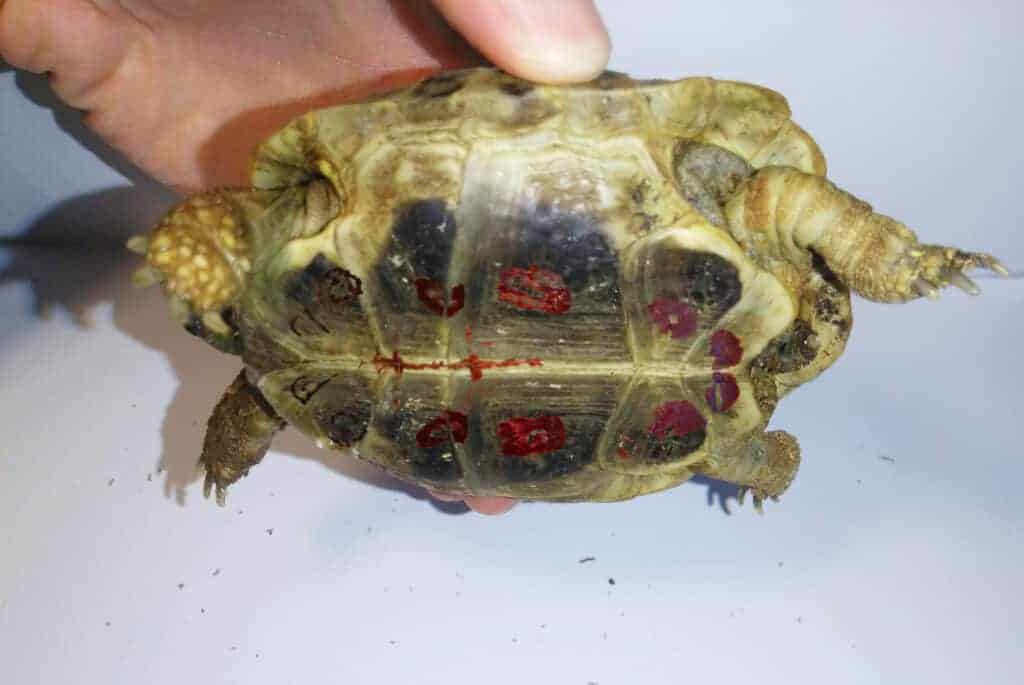
Red marks on your tortoises shell (the carpace) or underside (the plastron) could be a sign of Septicaemic Ulcerative Shell Disease (SCUD) or another form of Septicaemia. If you notice red markings then you should seek veterinarian advice from a reptile specialist as soon as you can. The veterinarian will be able to take blood samples and confirm whether your tortoise has Septicaemia.
Septicaemic Ulcerative Shell Disease (SCUD)
By the time most tortoise owners spot the red markings on their tortoise caused by SCUD, the Septicaemia is usually in the later stages and cannot be cured by antibiotics. This will result in the death of the tortoise.
SCUD is a specific form of shell rot which is found in tortoises. SCUD occurs when the bacteria responsible for shell rot spreads and start multiplying in your tortoises body. The bacteria is carried in your tortoises blood stream where it then attacks your tortoises organs. Other signs of SCUD, other than red markings to the shell and plastron, are as follows:
- Lethargy
- Lack of appetite
- Pitting to your tortoises shell.
- Septicaemia (Sepsis) in tortoises
Sepsis often presents itself after a tortoise has come out of hibernation so you should always give your tortoise a thorough check over when it wakes up. There is a common misconception that hibernation causes Sepsis in tortoises but this is a myth. Septicaemia is blood poisoning and occurs as a result of a pre-existing infection (like shell rot in the case of SCUD) which then goes on to enter the blood stream.
Other infections that can go on to cause Sepsis in tortoises include the following:
- Unnoticed open areas on the tortoises shell or limbs which have become infected.
- Insufficient winding down period before hibernation which means undigested food had been left in the tortoises digestive system which could release toxins.
- Underlying health issues which had not been diagnosed prior to hibernation such as a respiratory illness.
As with SCUD, by the time most tortoise owners spot the red markings on their tortoise, the Sepsis is usually in the later stages and cannot be cured by antibiotics. It is therefore imperative you try to deal with any infections as soon as they arise to prevent them from spreading and causing Sepsis.
It is also crucial that as a tortoise owner you understand how to hibernate safely. Unsafe hibernation practices put tortoise lives at risk. Before thinking about hibernation the tortoise should be checked over to ensure it is safe to hibernate. This should include a weight, length, parasite testing and physical check. If your tortoise is a female then a vet can also perform an ultrasound to ensure the tortoise is not retaining eggs prior to hibernation.
Signs of Sepsis in Tortoises
As with SCUD the tell tale sign of Sepsis in tortoises is dark red marks on the tortoises shell which don’t fade, even under pressure.
Shell rot in tortoises and what causes it?
Shell rot is a generic, umbrella term that covers the bacterial and fungal diseases of a tortoises shell. These diseases are often a result of shell trauma or can even be attributed to excessively damp conditions.
Fungal shell rot in tortoises can occur when the substrates in the tortoises enclosure are constantly damp. For example, substrates such as clay soil or grass will encourage shell rot. Shell rot is less likely to occur on a tortoise table due to the use of heat lamps which will dry out the substrates but shell rot is more of a concern in outdoor enclosure where tortoises are exposed to rain and in turn, damp conditions.
Dirty substrates can also lead to shell rot if the tortoise sustains an injury which then becomes infected.
Ticks can cause shell rot in tortoises so this is something to watch out for if you keep your tortoise in an outdoor enclosure. When a tick attaches itself to a tortoise it causes a penetrative injury which can allow bacteria to enter your tortoises body. You should regularly check your tortoise for ticks if it is kept in an outdoor enclosure.
Trauma to a tortoises shell can also cause shell rot. Shell trauma can occur as a result of a tortoise being dropped, something heavy falling on your tortoise or a an attack from a predatory animal. If the shell trauma leads to an open wound then shell rot can quite likely develop.
Signs of shell rot in tortoises
Signs of shell rot are:
– a discharge or unpleasant smell from the infected area.
– a softening or lifting of the shell plates.
– shell plates falling off.
– fluid appearing under the plates of the shell. This fluid can be reddish in appearance.
Treating shell rot in tortoises
Most cases of shell rot can be treated through the thorough cleansing of the infected area of the shell. Your veterinarian will be able to provide you with a povidone-iodine or chlorhexidine solution to cleanse the shell.
Remember that shell rot is highly contagious so your tortoise will need to be removed from its enclosure if it shares it with other tortoises. The likelihood that it will pass the disease to the other tortoises is extremely high.
As always, if you suspect your tortoise has shell rot we recommend you seek urgent veterinarian advice. If shell rot is left untreated it can be fatal but if it is is caught in the early stages it is usually highly treatable and your tortoise should make a full recovery.



